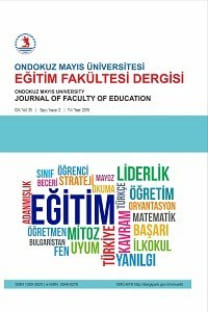L’Exploitation de La Chanson en Classe de Langue Etrangere
Müzik, şarkı, dinleme, sözel ifade, Fransızca öğrenme
Exploitation of Songs in Foreign Language Classrooms
Musique, chanson, écoute, expression orale, apprentissage du français,
___
- BONHOMME C. (1977). “Rencontres avec la poésie”, Les livres pour les enfants, les éditions ouvrières, Paris, p.124.
- KÖMÜRCÜ İ. (2007). “Cumhuriyet dönemi çocuk şarkılarının konuları bakımından incelenmesi”, II. Ulusal Çocuk ve Gençlik Edebiyatı Sempozyumu, Ankara Üniversitesi Basımevi, s.585.
- POSLANİEC C. (1990). Donner le Goût de Lire, Editions du Sorbier, Paris, p.69
- PRATX P. (1999). Des Chansons pour des situations de communication, “le français dans le monde”, Hachette, No 303, Mars-Avril-. P.38
- SOURİAU E. (1969). La correspondance des arts, Flammarion, Paris. P.162
- ISSN: 1300-302X
- Yayın Aralığı: 2
- Başlangıç: 1986
- Yayıncı: Ondokuz Mayıs Üniversitesi Eğitim Fakültesi
L'Exploitation de la chanson en classe de langue etrangere
Yetiştirme Yurdunda Kalmış Yetişkinlerin Devlet ve Vatandaşlık Algıları Üzerine Nitel Bir Araştırma
Fen Bilgisi Öğretmen Adaylarının Deney Tasarlama ve Uygulama Sürecine İlişkin Görüşleri
Tarihsel Romanın Eğitimsel İşlevi Üzerine Bir Çalışma: “Diriliş” Romanı Örneği
Pelin İskender KILIÇ, Pelin İskender KILIÇ
Öğretmen Adaylarının Amaç Yönelimleri ile Yapılandırmacılığa Yönelik Görüşlerinin İncelenmesi
Yaşam Temelli ARCS Öğretim Modeliyle 9. Sınıf Kimya Dersi “Hayatımızda Kimya” Ünitesinin Öğretimi
